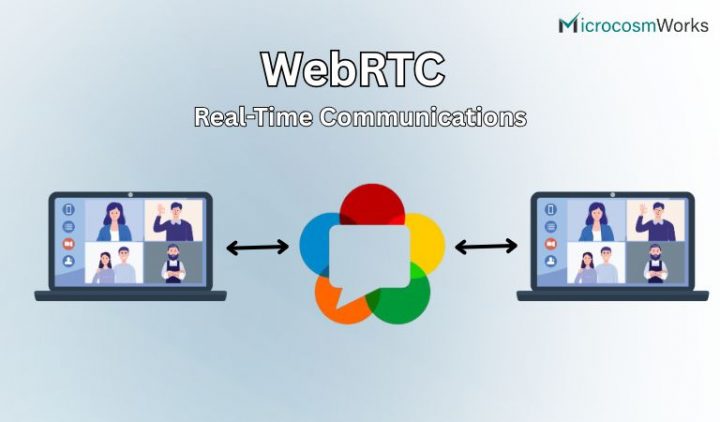An open-source initiative and standard called WebRTC (Web Real-Time Communication) enables devices, mobile apps, and browsers to communicate in real-time via data, video, and audio, without the need for plugins or other software.
It was developed by Google and standardized by W3C and IETF.
Think of it as the technology behind:
- Google Meet, Zoom (web version), Microsoft Teams in-browser
- Peer-to-peer file sharing
- Interactive gaming or IoT streaming
WebRTC Architecture

At a high level, WebRTC has four main building blocks:
1. Media Capture and Streams
Uses the browser APIs to access hardware devices:
- getUserMedia() → captures audio/video (camera, mic).
- getDisplayMedia() → screen sharing.
Produces a MediaStream object that can be sent over the network.
2. RTCPeerConnection
The core API that manages the connection between peers.
Handles:
- Media transfer (audio/video streams).
- Encryption (DTLS-SRTP).
- NAT traversal (ICE framework).
- Network adaptation (jitter buffer, packet loss concealment).
3. RTCDataChannel
- Enables bi-directional, low-latency data transfer between peers.
- Works like WebSockets but direct and P2P.
- Use cases: file sharing, chat messages, multiplayer gaming.
4. Signaling (External Component)
- WebRTC itself does not define signaling.
- Apps must provide a signaling mechanism (e.g., WebSocket, HTTP, MQTT).
- Purpose:
- Exchange session descriptions (SDP).
- Share ICE candidates (possible network paths).
Browser Implementation (Under the hood working)
Since we have understood the key components involved in WebRTC, let us now know what actually happens when Browser A tries to make a connection request to Browser B.
1. Media Capture
- Browser A calls navigator.mediaDevices.getUserMedia() to capture camera/mic.
- This produces a MediaStream object (audio/video tracks)
2. Create PeerConnection
- Browser A creates an RTCPeerConnection object.
- The MediaStream tracks are added to it (pc.addTrack()).
3. Create an Offer (SDP)
- Browser A generates an SDP Offer (Session Description Protocol).
- Contains:
- Supported codecs (H.264, VP8, Opus).
- Media capabilities (audio/video).
- Network transport details (candidates).
- Contains:
Example: pc.createOffer()
4. Send Offer via Signaling
- WebRTC does not handle signaling itself.
- The SDP Offer is sent to Browser B using a signaling server (WebSocket, HTTP, etc.).
5. Browser B Receives Offer
- Browser B gets the SDP Offer.
- It creates its own RTCPeerConnection.
- It sets A’s offer as its remote description.
6. Create Answer (SDP)
- Browser B generates an SDP Answer that:
- Agrees on codecs.
- Lists its own media/network capabilities.
Example: pc.createAnswer()
7. Send Answer via Signaling
- Browser B sends the SDP Answer back to Browser A through the signaling server.
- Browser A sets this as its remote description.
8. ICE Candidate Gathering
- Both browsers gather possible ICE candidates:
- Local IPs.
- Public IPs via STUN.
- Relay IPs via TURN (if needed).
- Candidates are exchanged (again via signaling).
9. Connectivity Checks
- Both peers run ICE connectivity checks:
- Test possible network paths.
- Pick the best one (direct if possible, otherwise relay through TURN).
10. DTLS Handshake (Encryption)
- Once a working path is found:
- The peers perform a DTLS handshake (for key exchange).
- They agree on encryption keys.
- Media is encrypted using SRTP (Secure RTP).
11. Media/Data Transmission
- At this point, the peer-to-peer connection is established.
- Audio/video streams flow directly between Browser A and Browser B.
- Optional: DataChannel is also established for arbitrary data exchange
Conclusion
WebRTC enables Browser A and Browser B to establish a direct, encrypted channel for real-time communication, while the signaling server only helps in setup, not in actual media transfer.
This makes WebRTC ideal for video conferencing, live streaming, gaming, and IoT scenarios where WebRTC peer-to-peer and streaming architecture are beneficial. For large-scale applications, it often relies on SFU/MCU servers to efficiently handle multiple participants (WebRTC SFU MCU servers).
Read More:- AI Services in 2025: The Future of Smart Enterprises




